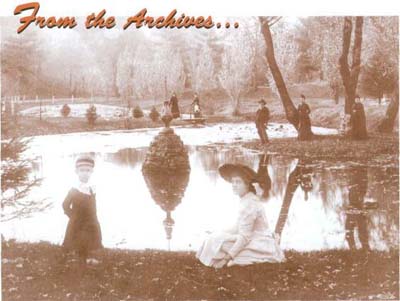 |
Home | Search | Browse | About IPO | Staff | Links |
 |
Home | Search | Browse | About IPO | Staff | Links |
|

By Edward J. Russo This evocative photograph emanates with a surreal, other-worldly quality. But that's not so surprising - the scene is Springfield's Oak Ridge Cemetery, probably in the 1890s. The photographer, whose name is now lost to us, intended to portray the sylvan beauty of a landscape in early autumn. Landscape photography such as this was quite the rage in the last half of the nineteenth century. The invention of photography in the 1800s was originally considered a serious challenge to painting, which to most people, was simply a way to record scenes from life. The veracity of the camera's eye eclipsed that of the most painstaking artist. Notwithstanding, photo artists began to consciously "interpret" their subject in a painterly way, searching for pockets of natural or manmade landscape that represented the beautiful or sublime to use as backdrops. This sort of moody landscape scene resulted. Related to the development of public parks, the landscaped cemetery movement of the nineteenth century gave Victorians places to escape the city and stroll or drive in a verdant scene. Oak Ridge is a premiere example of the rural cemetery movement, named for its location and bucolic appearance. The Victorians sentimentalized death and these "sleeping places of the dead" were now beautifully arrayed, and, according to one historian, evoked "a romantic pastoralism with its broken classical columns, hills, groves, water and walks...a sacred grove whose fecundity of trees and flowers subverted the [grief of] willing mourners." Oak Ridge was designed by William Saunders, a leading American landscape architect responsible for its curving drives and naturalistic plantings. Around the now vanished ponds are cemetery superintendent Meredith Cooper and family including his young daughter Annie Cooper Ward, in the foreground. What was in the minds of these ghostly figures? We will never know; like the ponds by which they posed, the Cooper family is gone from the local landscape. But we do know what became of the little boy, Robert Watson Kuecher, dressed in cap and skirt in the foreground. He grew up as Bobby Watson, a minor character actor in Hollywood, whose greatest claim to fame was playing Adolf Hitler in several films, including Hal Roach's "slapstick comedy" version. Altogether an unsettling vignette, from more than a century ago. Springfield City Historian Edward J. Russo is director of Lincoln Library's Sangamon Valley Collection. 22 ILLINOIS HERITAGE |
|
|